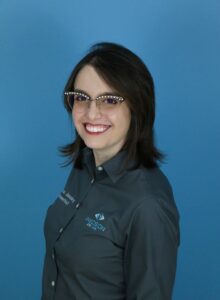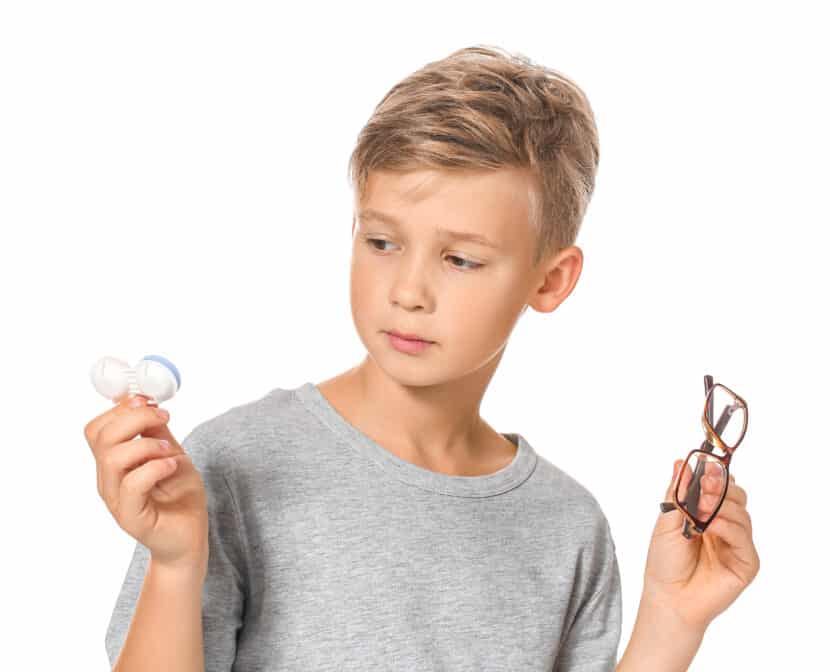It’ s back to school time. There are lots of decisions to make. Which clothes to purchase? Which back pack to choose? Glasses or contacts this year? Hmmm…
Once a proper set of contacts are found, they will be sent home with your child to test out for a week, so that your child can evaluate their comfort and clarity. Your child is usually asked to return in a week, wearing the lenses, so that the eye care team can re-evaluate the lens performance. This is your child’s opportunity to report any issues with the contact lens. If the lenses performed well, then the contact lens prescription will be released and contact lens boxes can be ordered. Otherwise, a different brand or prescription would be dispensed to test out for a week.
To have the most successful contact lens fitting, we recommend:
How Old Does My Child Need to be Before He/She Can Wear Contacts?
There is no age minimum for wearing contacts. Instead, it depends on the maturity of your child. To determine if your child is ready, ask yourself these questions:- Is your child responsible?
- Does your child exhibit good hygiene without prompting?
- Is your child able to tolerate having eye drops instilled?
- Is your child motivated to wear contacts?
- Clean and care for the contacts every day – otherwise an eye infection may ensue.
- Touch his eye – the contacts cannot go in otherwise.
- Be patient and not become easily flustered. It takes time and practice to insert and remove lenses quickly, and an easily discouraged child will not be successful.
- Get up earlier to insert the contacts – again, it takes time and practice.
- Throw out the contacts according to the doctor’s instructions – over-worn contacts can result in infections, oxygen deprivation, ulcers, and even blindness if misused.
- Be excited about wearing contacts – unmotivated children will not be successful no matter how determined the parents are to move them to contacts.
What are the Advantages of Contact Wear?
Wearing contact lenses are great for:- Children who are concerned about the stigma of wearing glasses and want to boost their self confidence
- Children engaged in sports who are concerned about damaging their glasses
- Children who are active outdoors and need to wear sunglasses
- Children who have high prescriptions who would see better in contacts
Which are the Best Contact Lenses for My Child?
Selecting the best contacts for your child depends on your goals.Soft Lenses
If your goal is to have the most comfortable, healthiest lens, and convenient lens, then the best option would be a soft, daily disposable lens. A daily disposable lens is thrown out every day. It is the most comfortable, because you only have one day’s worth of deposits and allergens on the lens before you replace it with a clean lens. It is the healthiest lens, because they are discarded before bacteria and viruses have the opportunity to take hold. It is the most convenient, because you do not have to clean these lenses -just discard them at the end of the day.Hard (a.k.a. Rigid Gas Permeable) Lenses
If your goal is to have the best vision and to prevent the prescription from worsening, then a hard lens is the way to go. While a soft lens conforms to the cornea, a hard lens keeps its shape, giving you the best optics and the best vision. It also acts like a retainer on the eye, holding the cornea in its current shape which prevents prescription changes. Usually, a hard contact lens lasts one year, making it an economical choice as long as it isn’t lost or damaged. Hard lenses aren’t as comfortable as soft lenses initially, and they don’t perform as well in a dusty environment.Orthokeratology (a.ka. Ortho-K) Lenses
If your goal is freedom from wearing glasses or contacts during the day, then an Ortho-K lens is the best option. An Ortho-K lens is a special type of hard lens that is only worn at night to mold the cornea into the correct shape. It gently reshapes the cornea, similar to how braces move teeth, so that during the day, your child can see 20/20 without wearing anything. If your child stops wearing the Ortho-K lens, his/her prescription will return to their original glasses prescription. You do not need to wait for your child’s eyes to stabilize to be fit into an Ortho-K lens.Contact Lens Fittings: What are They and What Should I Expect From Them?
A contact lens fitting is the process of trying on contacts to ensure that the contacts provide clear, comfortable vision, fit properly on the eye, and there are not any health complications related to contact lens wear. During the fitting, your eye care team will:- Place lenses on your child’s eye
- Measure the vision
- Evaluate the fit of the lenses
- Teach your child how to safely insert and remove the lenses
- Educate your child on how to clean and care for the contact lenses
Once a proper set of contacts are found, they will be sent home with your child to test out for a week, so that your child can evaluate their comfort and clarity. Your child is usually asked to return in a week, wearing the lenses, so that the eye care team can re-evaluate the lens performance. This is your child’s opportunity to report any issues with the contact lens. If the lenses performed well, then the contact lens prescription will be released and contact lens boxes can be ordered. Otherwise, a different brand or prescription would be dispensed to test out for a week.
To have the most successful contact lens fitting, we recommend:
- Scheduling the fitting for a day when you are not pressed for time. It typically takes a new contact lens wearer 45 minutes to insert a lens for the first time.
- Relax in the reception area while your child is learning to insert and remove lenses. It helps reduce performance anxiety caused by a parent watching.
- When possible, leave the rest of the family at home for this appointment. It puts a lot of pressure on the new contact lens wearer if he/she knows that others are waiting on him.
Are Contacts a Complete Substitute for Glasses?
No, contacts are not a complete substitute for glasses. Your child will still need a pair of glasses in case allergy eyes, irritation, or infection prevent him/her from wearing their contacts. Glasses provide a great back up in case a lens is torn or lost, especially when it’s the last lens you have. Glasses are also handy in less sanitary environments (i.e. camping trips). Finally, glasses give the eyes a chance to breathe, since contacts do block some of the oxygen from reaching the eye.Where Can I Find More Information?
If you think your child might be ready for contacts, please talk with your eye doctor. They will be able to run the appropriate tests to determine if your child is a good candidate and which contacts would be best.
Lisa Januskey
Dr. Januskey '02 is the owner and developmental optometrist at Precision Eye Care. Her goal is to provide others with the eye health and vision they need to be successful and improve the lives of others. She especially enjoys treating binocular vision disorders and pediatric optometry.

